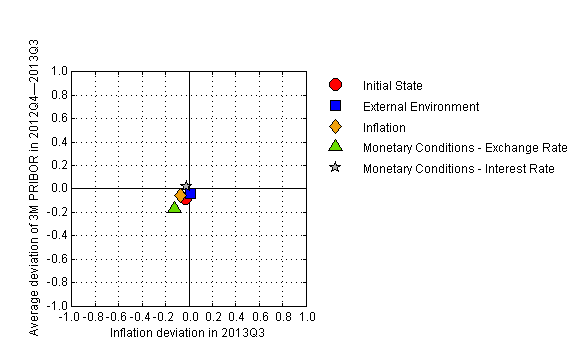Graph of Risks to the Inflation Projection (GRIP)
6th Situation Report 2012
The model simulation results captured in the GRIP represent an accumulation of slightly anti-inflationary risks to the inflation forecast published in Inflation Report III/2012. This is due to a stronger-than-forecasted exchange rate of the koruna and weaker-than-forecasted domestic economic activity, wages and inflation. The effect of the external environment on the balance of risks is almost neutral, with a lower euro area interest rate outlook being offset by revised outlooks for external demand and industrial producer prices.
Other risks and uncertainties lie outside the GRIP simulation. As the package of tax law changes has not been approved, the probability has risen that the proposal which, among other things, increases both VAT rates by 1 percentage point in January 2013 will not be passed. Under the current legislation, this would mean harmonisation of the VAT rates at 17.5%, representing a downside risk to headline inflation, while non-adoption of the VAT changes would have a slight upward impact on monetary-policy relevant inflation and interest rates. The currently elevated commodity prices and their higher outlook are also acting in the inflationary direction. By contrast, the currently stronger exchange rate compared to the average for the course of the quarter used in the GRIP simulation is fostering lower inflation and interest rates. The uncertainty surrounding the evolution of the euro area debt crisis remains substantial.
According to the Monetary and Statistics Department, the overall balance of risks to the Inflation Report III/2012 forecast is tilted to lower monetary-policy relevant inflation and interest rates. The downside risk to headline inflation is stronger than in the case of monetary-policy relevant inflation due to the possible non-adoption of higher VAT rates in 2013.
